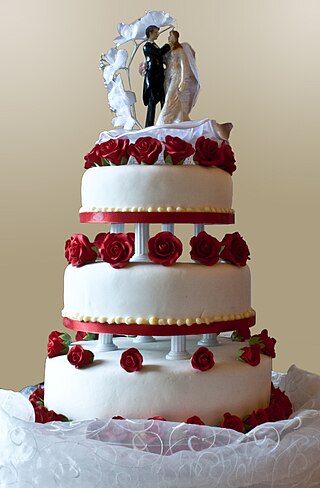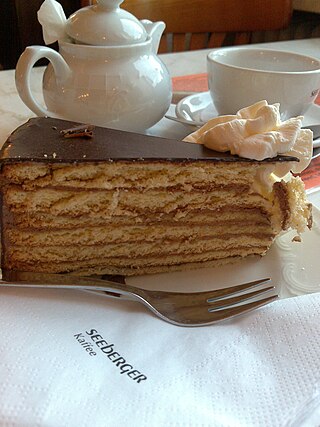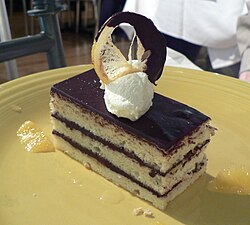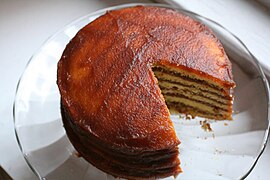
Cake is a flour confection made from flour, sugar, and other ingredients and is usually baked. In their oldest forms, cakes were modifications of bread, but cakes now cover a wide range of preparations that can be simple or elaborate and which share features with desserts such as pastries, meringues, custards, and pies.

A wedding cake is the traditional cake served at wedding receptions following dinner. In some parts of England, the wedding cake is served at a wedding breakfast; the 'wedding breakfast' does not mean the meal will be held in the morning, but at a time following the ceremony on the same day. In modern Western culture, the cake is usually on display and served to guests at the reception. Traditionally, wedding cakes were made to bring good luck to all guests and the couple. Nowadays, however, they are more of a centerpiece to the wedding and are not always even served to the guests. Some cakes are built with only a single edible tier for the bride and groom to share, but this is rare since the cost difference between fake and real tiers is minimal.

Icing, or frosting, is a sweet, often creamy glaze made of sugar with a liquid, such as water or milk, that is often enriched with ingredients like butter, egg whites, cream cheese, or flavorings. It is used to coat or decorate baked goods, such as cakes. When it is used between layers of cake it is known as a filling.

A cupcake (AmE), fairy cake (BrE), or bun (IrE) is a small cake designed to serve one person, which may be baked in a small thin paper or aluminum cup. As with larger cakes, frosting and other cake decorations such as fruit and candy may be applied.

A mille-feuille, also known by the names Napoleon in North America, vanilla slice in the United Kingdom, and custard slice, is a French dessert made of puff pastry layered with pastry cream. Its modern form was influenced by improvements made by Marie-Antoine Carême.

Kuchen, the German word for cake, is used in other languages as the name for several different types of savory or sweet desserts, pastries, and gateaux. Most Kuchen have eggs, flour and sugar as common ingredients while also, but not always, including some fat. In Germany it is a common tradition to invite friends over to one's house or to a cafe between noon and evening to drink coffee and eat Kuchen.

A Swiss roll, jelly roll, roll cake, cream roll, roulade or Swiss log is a type of rolled sponge cake filled with whipped cream, jam, icing, or any type of filling. The origins of the term are unclear; in spite of the name "Swiss roll", the cake is believed to have originated elsewhere in Central Europe, possibly Austria or Slovenia. It appears to have been invented in the nineteenth century, along with Battenberg cake, doughnuts, and Victoria sponge. In the U.S., commercial snack-sized versions of the cake are sold with the brand names Ho Hos, Yodels, Swiss Cake Rolls, and others. A type of roll cake called Yule log is traditionally served at Christmas.

Chocolate cake or chocolate gâteau is a cake flavored with melted chocolate, cocoa powder, or both.

A génoise, also known as Genoese cake or Genovese cake, is a French sponge cake named after the city of Genoa and associated with French cuisine. It was created by François Massialot in the late 17th century. Instead of using chemical leavening, air is suspended in the batter during mixing to provide volume.

A torte is a rich, usually multilayered, cake that is filled with whipped cream, buttercreams, mousses, jams, or fruit.

Dobos torte, also known as Dobosh, is a Hungarian sponge cake layered with chocolate buttercream and topped with caramel. The layered pastry is named after its inventor, Hungarian chef József C. Dobos, a delicatessen owner in Budapest. In the late 1800s, he decided to create a cake that would last longer than other pastries in an age when cooling techniques were limited. The round sides of the cake are coated with ground hazelnuts, chestnuts, walnuts, or almonds, and the hardened caramel top helps to prevent drying out, for a longer shelf life.

Doberge cake is a layered dessert originating in New Orleans, Louisiana, U.S., adapted by local baker Beulah Ledner from the Hungarian Dobos torte. Still popular in the area, the cake is made of multiple thin layers of cake alternating with dessert pudding. Very often the cakes are made with half chocolate pudding and half lemon pudding. They are covered in a thin layer of butter cream and a fondant shell or, alternatively, a poured glaze on the outside. They are normally made with six or more layers. Traditional flavors are chocolate, lemon or caramel.

Cake decorating is the art of decorating a cake for special occasions such as birthdays, weddings, baby showers, national or religious holidays, or as a promotional item.

Prinzregententorte is a Bavarian torte consisting of at least six, usually seven, thin layers of sponge cake interlaid with chocolate buttercream. The exterior is covered in a dark chocolate glaze. Prinzregententorte is very popular in Bavaria, Germany, and available in cake shops all year round.

Sponge cake is a light cake made with eggs, flour and sugar, sometimes leavened with baking powder. Some sponge cakes do not contain egg yolks, like angel food cake, but most of them do. Sponge cakes, leavened with beaten eggs, originated during the Renaissance, possibly in Spain. The sponge cake is thought to be one of the first non-yeasted cakes, and the earliest attested sponge cake recipe in English is found in a book by the English poet Gervase Markham, The English Huswife, Containing the Inward and Outward Virtues Which Ought to Be in a Complete Woman (1615). Still, the cake was much more like a cracker: thin and crispy. Sponge cakes became the cake recognised today when bakers started using beaten eggs as a rising agent in the mid-18th century. The Victorian creation of baking powder by English food manufacturer Alfred Bird in 1843 allowed the addition of butter to the traditional sponge recipe, resulting in the creation of the Victoria sponge. Cakes are available in many flavours and have many recipes as well. Sponge cakes have become snack cakes via the Twinkie.

Coconut cake is a popular dessert in the Southern region of the United States. It is a cake frosted with a white frosting and covered in coconut flakes.

Zuger Kirschtorte is a Swiss layer cake that consists of layers of nut-meringue, sponge cake and butter cream, and is flavoured with the cherry brandy kirschwasser.
The fourth season of The Great Canadian Baking Show premiered on CBC Television on February 14, 2021. As with previous seasons, ten amateur bakers will compete over eight weeks of challenges, vying for the title. The season marked the debut of Ann Pornel and Alan Shane Lewis as hosts, who replaced Carolyn Taylor and Aurora Browne. Bruno Feldeisen and Kyla Kennaley returned for their fourth and second seasons respectively as judges.

Dobash cake, is a layered chocolate cake filled and topped with a chocolate pudding-like frosting originating in Hawaii, adapted by local baker Robert Taira from the Hungarian Dobos torte. The cake is made of two to three layers of chocolate chiffon cake alternating with dessert pudding, sometimes dusted with crumbs.

























